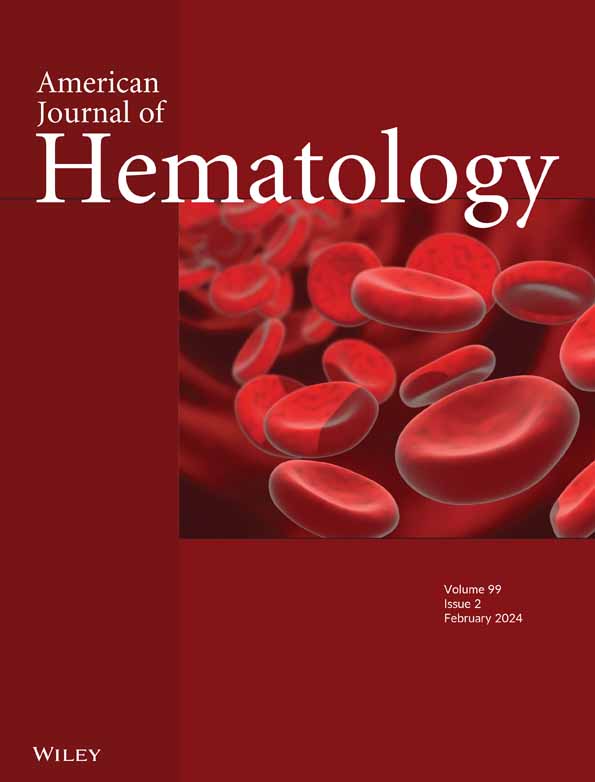突发性夜间血红蛋白尿患者突破性溶血的特征:一项国际多中心经验。
IF 9.9
1区 医学
Q1 HEMATOLOGY
引用次数: 0
摘要
突破性溶血(BTH)被定义为阵发性夜间血红蛋白尿(PNH)患者接受补体抑制剂(CIs)治疗时溶血恶化。在目前几种终端和近端抑制剂的时代,没有定义BTH及其严重程度的指南,临床管理也不规范。这项回顾性、观察性和多中心研究评估了2007年至2025年2月在意大利(9个中心)和英国(1个中心)的10个中心接受补体抑制剂治疗的PNH患者的BTH频率和严重程度。198例患者中有102例(51%)发生了271例BTH事件,其中36/198(18%)患者在18年的随访中经历了3次或以上BTH事件。大多数事件(55%)是由感染引起的,24例(10%)与口服替代途径抑制剂依从性差有关。约一半患者的BTH临床严重,46%需要输血,17%需要调整CI剂量,16%需要抗凝预防。总体而言,5例(2%)突破性血栓事件发生在未采取预防措施的患者中,均发生在感染期间。BTH发病率为0.19例/患者年,近端抑制剂最高(0.4例/患者年),抗c5较低(0.18例/患者年)。通过logistic回归分析,BTH的主要预测因素是诊断时疾病更严重(LDH升高,首次使用补体抑制剂时间更短),近端抑制剂治疗,EBMT反应类别较差。本文章由计算机程序翻译,如有差异,请以英文原文为准。
Characterization of Breakthrough Hemolysis in Patients With Paroxysmal Nocturnal Hemoglobinuria: An International Multicenter Experience.
Breakthrough hemolysis (BTH) is defined as a hemolytic exacerbation in a patient with paroxysmal nocturnal hemoglobinuria (PNH) treated with complement inhibitors (CIs). In the current era of several terminal and proximal inhibitors, there are no guidelines for defining BTH and its severity, and clinical management is not standardized. This retrospective, observational, and multicentric study evaluated BTH frequency and severity in PNH patients treated with complement inhibitors from 2007 until February 2025 at 10 centers across Italy (9 centers) and the United Kingdom (1 center). A total of 271 BTH events occurred in 102 out of 198 patients (51%), with 36/198 (18%) patients experiencing 3 or more BTH episodes over the 18-year follow-up. Most events (55%) were prompted by infections, and 24 (10%) were linked to poor compliance with oral alternative pathway inhibitors. BTH was clinically severe in about half of patients, requiring transfusion in 46%, CI dosing adjustment in 17%, and anticoagulant prophylaxis in 16%. Overall, 5 (2%) breakthrough thrombotic events occurred in patients not on prophylaxis, all during an infection. BTH incidence was 0.19 events per patient-year, maximal with proximal inhibitors (0.4 events per patient-year), and lower for anti-C5 (0.18 per patient-year). By logistic regression analysis, the main predictors of BTH were more severe disease at diagnosis (increased LDH and a shorter time to first complement inhibitor), treatment with proximal inhibitors, and poorer EBMT response category.
求助全文
通过发布文献求助,成功后即可免费获取论文全文。
去求助
来源期刊
CiteScore
15.70
自引率
3.90%
发文量
363
审稿时长
3-6 weeks
期刊介绍:
The American Journal of Hematology offers extensive coverage of experimental and clinical aspects of blood diseases in humans and animal models. The journal publishes original contributions in both non-malignant and malignant hematological diseases, encompassing clinical and basic studies in areas such as hemostasis, thrombosis, immunology, blood banking, and stem cell biology. Clinical translational reports highlighting innovative therapeutic approaches for the diagnosis and treatment of hematological diseases are actively encouraged.The American Journal of Hematology features regular original laboratory and clinical research articles, brief research reports, critical reviews, images in hematology, as well as letters and correspondence.

 求助内容:
求助内容: 应助结果提醒方式:
应助结果提醒方式:


